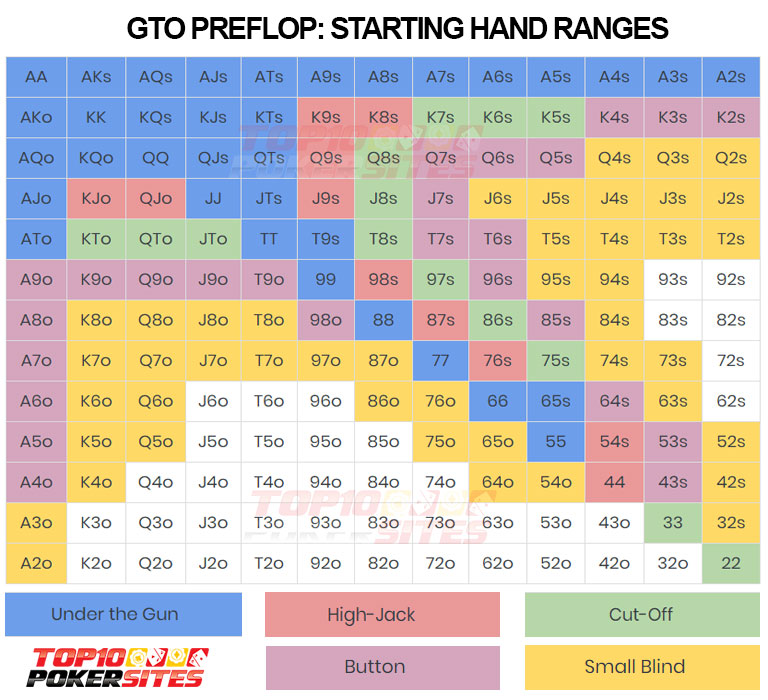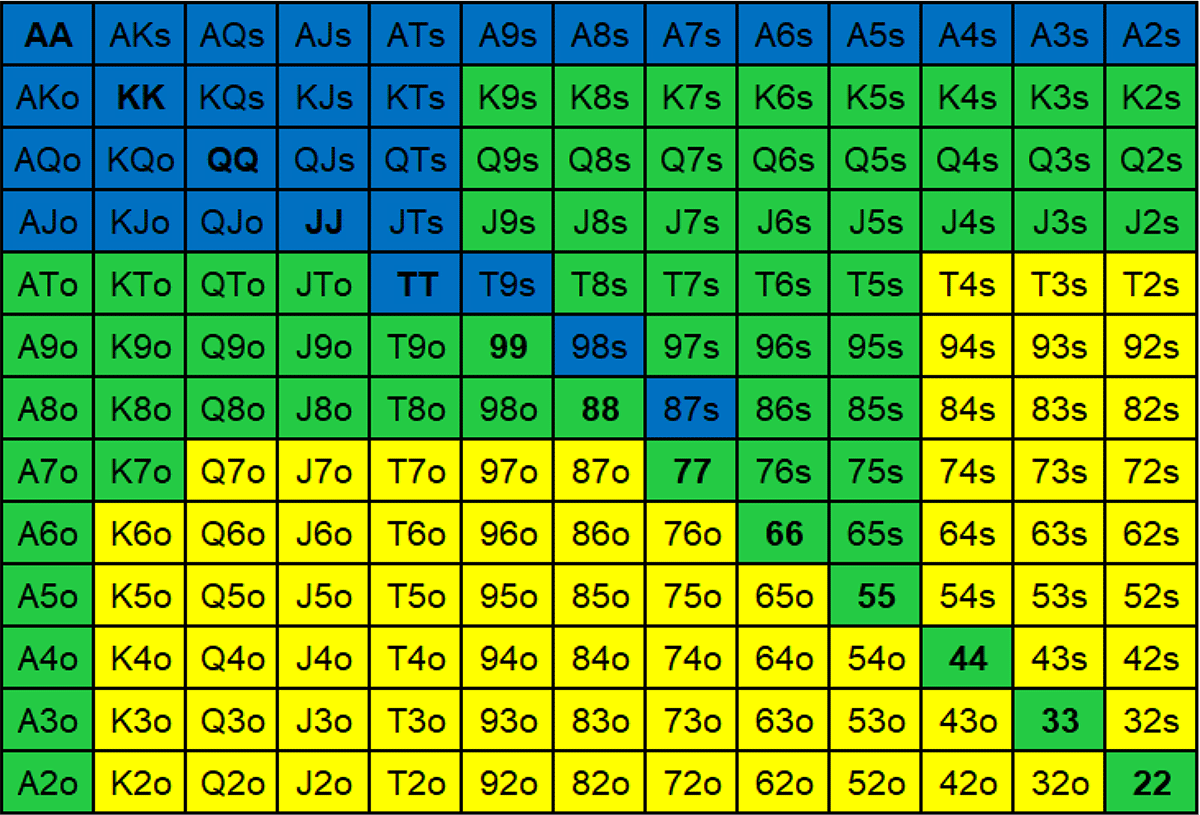Preflop Guru is a solver-based (GTO) preflop training site for advanced poker players. Master the preflop game. Preflop Guru is a solver-based (GTO) preflop training site for advanced poker players. Sign Up Now Benefits of Preflop Guru. Built from solvers (GTO) to beat the toughest games.
- Upswing Poker Preflop Chart
- Poker Pre Flop Raise Chart
- Poker Preflop Charts Tournament
- Upswing Poker Preflop Chart
- Poker Preflop Chart
- Poker Preflop Charts
Most Commonly Asked Poker Questions
- Like all things in poker, this advice is relative. The better you get at pre-flop concepts and post-flop play, the more hands you can add to your armory. Because you are just starting out, it is.
- Charts Winning poker starts with winning ranges. Our custom, solver-approved pre-flop ranges will give you instant feedback on how to improve your strategy and your winrate.
- Stick To Our Preflop Poker Strategy Gameplan. You need to stick to your preflop starting hand.
- Like all things in poker, this advice is relative. The better you get at pre-flop concepts and post-flop play, the more hands you can add to your armory. Because you are just starting out, it is.

Not sure what beats a full house or what a straight can beat? Here are the answers to the most commonly-asked poker questions this side of the Strip.
Does a flush beat a full house?
No. A full house beats a flush in the standard poker hand rankings. The odds against making a full house in a game of Texas Hold’em are about 36-to-1, while the odds against making a flush are 32-to-1. The full house is a more rare hand and beats a flush.
Does a flush beat a straight?
Yes. Using the standard poker hand rankings, a flush beats a straight, regardless of the strength of the straight. The odds against making a straight in Texas Hold’em are about 21-to-1, making it a more common hand than a flush (32-to-1 odds against).
Does a straight beat a full house?
No. The odds against making a full house in Texas Hold’em are about 36-to-1, while the odds against making a straight are about 21-to-1. Both are strong five-card hands, but a full house occurs less often than a straight. A full house beats a straight in the poker hand rankings.
Does three of a kind beat two pair?
Yes. Both three of a kind and two pair can make a lot of money in poker, but three of a kind is the best hand when it goes head to head with two pair. The odds against making three of a kind in Texas Hold’em is about 20-to-1, while the odds against making two pair is about 3-to-1.
Does three of a kind beat a straight?
No. The odds of making both of these hands are very close in a game of Texas Hold’em. The odds against making a straight are 20.6-to-1, while the odds against making three of a kind are 19.7-to-1. The straight comes about slightly less often, making it the winner against three of a kind in the poker hand rankings.
Does a flush beat three of a kind?
Yes. The battle of strong hands between a flush and three of a kind sees the flush as the stronger hand. The odds against making a flush in Texas Hold’em are about 32-to-1, with odds against making three of a kind at around 20-to-1.
Upswing Poker Preflop Chart
Does a straight beat two pair?
Yes. The poker hand rankings dictate that a straight is a stronger hand than two pair. The straight occurs with about 21-to-1 odds against in Texas Hold’em, while the odds against making two pair stand at about 3-to-1.
Does four of a kind beat a full house?
Yes. Both four of a kind and a full house are among the strongest poker hands, but four of a kind is a much rarer holding. Texas Hold’em odds against making four of a kind are 594-to-1, while you have about 36-to-1 odds against making a full house.
Does three of a kind beat a flush?
No. When the flush and three of a kind go head to head, the flush comes out as the best according to the poker hand rankings. The odds against making three of a kind sit around 20-to-1, with the odds against hitting a flush at 32-to-1.
Does a full house beat a straight in poker?
Yes. The full house comes in less often than a straight. In Texas Hold’em, the odds against drawing a full house are around 36-to-1, while the odds against making a straight are around 21-to-1.
Does a straight flush beat four of a kind?

Yes. Four of a kind is an exceedingly rare hand in poker, but the straight flush is an even more elusive five-card hand. The odds against making a straight flush in Texas Hold’em is about 3,590-to-1, much rarer than four of a kind (594-to-1 odds against)
Poker Pre Flop Raise Chart
This chart details the Hole Cards that we believe you should open with in an 8-max No-Limit Hold ‘Em tournament without antes – such as Match Poker Online’s™ Scrap game. They are dependent on your position, explained below.
The positions around a table in an 8-player game, clockwise from the Dealer Button, are:
- Button/Dealer (BTN)
- Small Blind (SB)
- Big Blind (BB)
- Under The Gun (UTG)
- Under The Gun +1 (UTG+1)
- Lojack (LJ)
- Hijack (HJ)
- Cutoff (CO)
CLICK HERE TO DOWNLOAD A PRINTABLE VERSION
How to interpret this chart:
Poker Preflop Charts Tournament
This chart shows all the possible Hole Cards you could be dealt – ‘s’ for ‘suited’ and ‘o’ for ‘offsuit’.
When you are UTG (i.e. directly to the left of the Big Blind), this chart suggests you should only open (i.e. bet first) with the cards in the Red boxes.
The same goes for UTG+1 (i.e. left of UTG).
When you are in the Lojack (LJ) or Hijack (HJ) positions, more hand combinations open up. The chart suggests you can now open with all of the cards in the Orange boxes in addition to the ones in the Red boxes.
Upswing Poker Preflop Chart
In the Cutoff position, even more hand combinations open up. The chart now suggests you can open with all of the cards in the Yellow boxes in addition to the ones in the Orange and Red boxes.
Next you reach the Button and Small Blind, where more options are available to you, including all of those that were available in the earlier positions. In these positions, the chart suggests you can open with any cards in any of the coloured boxes.
Any boxes that are white are those you would usually never open.
Poker Preflop Chart
Lastly, once you are familiar with this chart and have applied it in practise, you’ll begin to learn how to deviate from these guidelines when the situation calls for it. [Click here to learn why position is so important in poker!]

Learning to quickly recognise what position you are in and how this translates to what hands you should open with will quickly improve your play. We see nothing wrong with printing this guide out and following it religiously in Scrap games (as well as in the first stage of Elimination games) as you learn to find your feet in poker. Diligence is key at this stage in your learning.
Watch your Rating Points soar as you learn to follow this guide!
*Editors Note: We frequently get feedback from players that this chart has led them astray. For example: “I had K3o on the Button and folded, per this chart, and the Flop came out 3-3-K. I could’ve won 3000 chips because three other people played that hand, who I would’ve beaten.”
Poker Preflop Charts
To this, our response is that we apologise for leading you astray in that hand, but, in the long run, this chart will ensure you end up in front. We explain this in our article on Expected Value – an integral concept for all aspirational poker players.